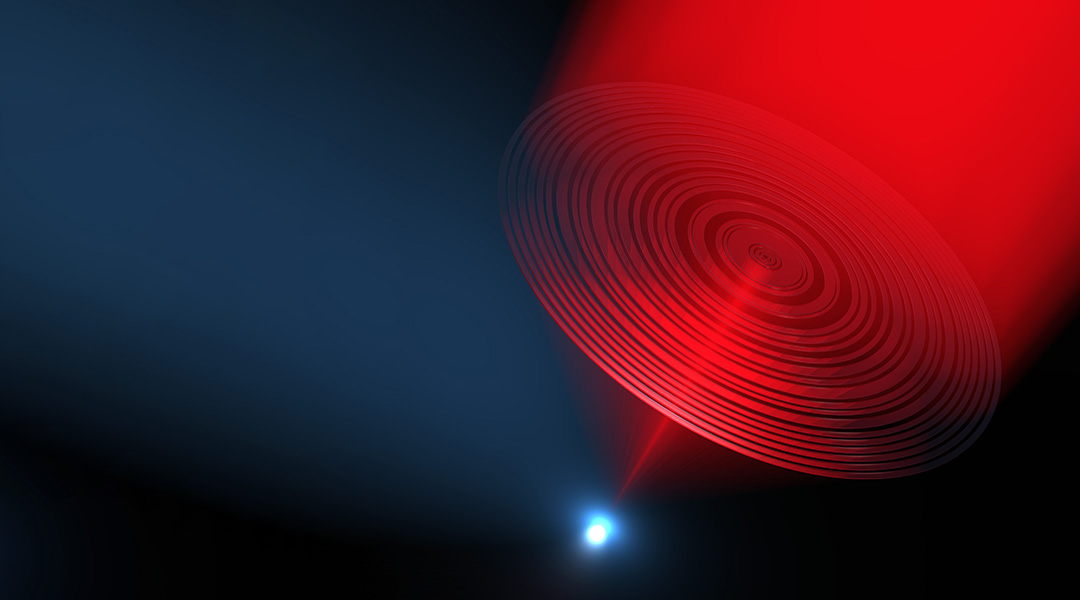Credited as the father of microbiology, Anton van Leeuwenhoek became the first person in 1677 to observe bacteria under a microscope, kickstarting a revolution in microscopy that continued through the 18th century. This allowed humanity to delve deeper into living things, discovering the cells that comprise animals and plants.
Eventually, optical microscopes met their limit defined by half the wavelength of the light being used — the classical diffraction limit. This means optical microscopes are able to resolve bacteria and cells but not some smaller subcellular structures, viruses, or proteins. Elements of living things with sizes smaller than around 10 nanometers, such as enzymes and DNA, for example, require electron microscopy to be seen.
Yet optical microscopes are preferable over electron microscopes because of their non-invasive nature when it comes to seeing within living things and observing cells and tissues to understand the processes that occur there.
Bright fluorescent markers, such as dye molecules, can be used for the specific labeling of sub-cellular structures and, hence, cellular functions and thus to push optical microscopes past the diffraction limit, but this has drawbacks. Not only is labeling of this type not suitable in all circumstances, but it can also be difficult to achieve. Additionally, labeling can lead to photo-toxicity — a toxic response elicited after exposure to chemicals and subsequent exposure to light — which can damage living cells or tissues.
Thus, scientists are keen on methods that can push optical microscopy without the need for dyes. Label-free super-resolution (LFSR) imaging relies on light scattering processes in nanoscale materials without the need for bright fluorescent markers.
“The label-free imaging is a type of optical microscopy or, in a broader sense, a type of electromagnetic imaging, which does not rely on the use of bright fluorescent markers such as dye molecules added to investigated biomedical or other structures to increase their contrast or to highlight particular structures of interest,” said Vasily Astratov, University of North Carolina at Charlotte, professor of Physics and Optical Science.
“This is a much-needed type of imaging in biomedical applications, but it pushes our understanding of underlying physical mechanisms beyond the classical diffraction due to such factors as the fundamental role of noise and information capacity of the optical system, the role of prior knowledge and AI science, near-field and nonlinear optics, as well as advanced superlens designs,” he continued.
The demands of LFSR as grows as a microscopy technique prompted Astratov and colleagues across 27 teams of researchers to create a roadmap for the future development of this process. The work of the team and their conclusions are documented in a paper published in the journal Laser & Photonics Reviews.
Astratov explained that this represents a first-of-its-kind vision of the past, present, and future developments in this area based on the physical mechanisms of LFSR imaging.
A roadmap into the nanoscale
Initially, the development of LFSR imaging was a gradual process based on introducing novel physical mechanisms to each other across a range of interdisciplinary concepts. The development of LFSR burgeoned in the last two decades thanks to three major developments.
The first of these was the realization that imaging is a problem that can be tackled by machine learning using different forms of prior knowledge about objects, training of imaging systems considered to be deep-learning networks, and, finally, using artificial intelligence for recognizing images and improving the resolution of optical instruments.
Second was the development of structured illumination microscopy — the use of structured illumination, such as interference patterns between wavelengths of light, to make high spatial frequencies visible to microscopes. The third vital aspect of the development of LFSR was the development of novel optical concepts such as “perfect” lenses, superlenses, and hyperlenses, as well as the development of transformation optics in the context of metamaterials and other substances.
Research co-author and UCLA professor Aydogan Ozcan pointed out it is these developments which caused an explosive growth of LFSR imaging.
“To some extent, this is similar to the revolution we experience in everyday life as a result of the explosive growth of more general AI ideas, which reached the point of consideration and concern,” Ozcan said. “In the case of LFSR imaging, it is not a concern, but rather a combination of explosive growth and lack of methodology and systematic approach to this field, which created an urgent need for developing a vision of the future of this field in general and for this roadmap in particular.”
He added that in the past, studies of LFSP imaging were conducted in physics and biomedical optics communities, which have separate conferences and different research priorities. The aim of Astratov and colleagues was to instead bring communities under the same umbrella and create synergistic interaction between approaches to LFSR.
“This area lies at the forefront of modern optics and photonics because it touches on every aspect of our understanding of basic principles behind the concept of optical resolution,” Astratov explained.
With the history of LFSR in the rearview mirror, the team pointed out that the interplay of these different mechanisms and aspects creates new opportunities for improving LFSR imaging.
Bumps in the road and off-roading for LFSR
Astratov, Ozcan and colleagues point out that there are several bumps in the road ahead for LFSR.
“The realization of super-resolution in label-free imaging usually implies that certain tradeoffs need to be explored, and the nature of these tradeoffs varies for different mechanisms,” University of Southampton researcher and study co-author Nikolay Zheludev explained.
He added that this could include, but is not limited to, the tradeoff between the size of the nanoscale aperture probe used and the signal-to-noise ratio achieved or, for machine learning approaches, a trade-off between the depth of learning, the complexity of the task at hand and the amount of prior knowledge incorporated into the system.
Fortunately, bringing together 27 different international groups means that the “bumps in the road” for LFSR identified are being approached from what Astratov described as “almost all possible directions”. These angles included pure theory, experimental demonstration of super-resolution capability, and practical implementation of LFSR methods in biomedical research and material characterization.
However, this approach has its limitations, and the team was willing to do a little “off-roading” to go beyond its scope, which was built around optical wavelengths of light in microscopy and imaging. The team points out that LFSR concepts are applicable at longer wavelengths, which leads to expanded usage for this technique.
“Microwaves can be used for imaging through strongly scattering media — clouds, tissue, sandstorms, water, and snow,” Zheludev said. “Exploiting extremely low and very low-frequency background electromagnetic waves, combined with computational methods, can lead to imaging through almost anything, anywhere.”
Reference: V. N. Astratov., et al., Roadmap on Label-Free Super-Resolution Imaging, Laser & Photonics Reviews, (2023), DOI: 10.1002/lpor.202200029
Feature image credit: Phil Saunders/University of Southampton
This article was updated on November 28, 2023 to correct the spelling of Vasily Astratov.

















